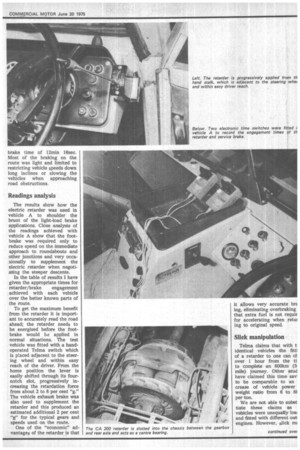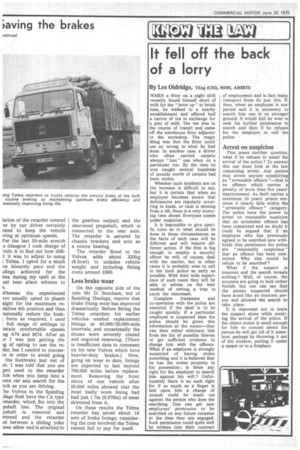Saving the brakes
Page 66

Page 67

Page 68

If you've noticed an error in this article please click here to report it so we can fix it.
kssessing the electromagnetic retarder on haulage trunk work
LTHO UGH many British )ach operators have had elecic retarders fitted to their ?hides, few of their haulage )uniterparts have taken up the vice. It seems that the cost = the equipment has been the am n deterrent, perhaps trough a failure to appreciate ie potential for long-term wings—especially in brake 4ines—and the very importit safety aspect of keeping te service brakes cool and ady to give their best in an nergency.
Fight run to Glasgow
To get a first-hand view of ie cost and safety aspects in lulage work I recently visited palding Haulage Ltd, St thn's Road, Spalding, Lincs, hich operates a fleet of olvo F88 tractive units each :ted with a Telma retarder. le purpose of the visit was vofold: to assess the use of Le retarder during normal serce, and to discuss with the )erators the benefits to be ytained.
For the on-road test I accompanied two of the company's vehicles on a regular night run from Spalding to Glasgow. Vehicle A was instrumented by Telma engineers so that the engagement times for the Telma retarder and the footbrake could be recorded. Only the footbrake was instrumented on vehicle B as the retarder was not to be used. The regular crews were used in both vehicles and they were asked to drive normally in order to allow an accurate comparison of brake usage to be made.
The 450km (280-mile) test route ran from Spalding to Newark on A17 to pick up Al and then turning off Al at Scotch Corner on to A66. From A66 we branched on to M6 at Penrith and followed M6/A74 trb 'Elvan Foot Service Station about 50 miles south of Glasgow.
The two vehicles kept to a tight schedule with the speedometer needles being kept up to the legal maximum road speeds whenever it was safe to do so. Starting off at Spalding at around 8pm we arrived in Glasgow at 6am, and only very light traffic was encountered throughout the night.
Over the test route the footbrake on vehicle A was used for a total of just 43sec with the retarder being energised for a total time of nearly 21min. Vehicle B, without the retarder, returned a total foot brake time of 12min 16sec. Most of the braking on the route was light and limited to restricting vehicle speeds down long inclines or slowing the vehicles when approaching road obstructions.
Readings analysis
The results show how the electric retarder was used in vehicle A to shoulder the brunt of the light-load brake applications. Close analysis of the readings achieved with vehicle A show that the footbrake was required only to reduce speed on the immediate approach to roundabouts and other junctions and very 'occasionally to supplement the electric retarder when negotiating the steeper descents.
In the table of results I have given the appropriate times for retarder/brake engagement achieved with each vehicle over the better known parts of the route.
To get the maximum benefit from the retarder it is important to accurately read the road ahead; the retarder needs to be energised before the footbrake would be applied in normal situations. The test Vehicle was fitted with a handoperated Telma switch which is placed adjacent to the steering wheel and within easy reach of the driver. From the home position the lever is easily shifted through its fournotch slot, progressively increasing the retardation force from about 2 to 8 per cent "g." The vehicle exhauSt brake was also used to supplement the retarder and this produced an estimated additional 2 per cent "g" for the typical gears and speeds used on the route.
One of the "economic" advantages of the retarder is that it allows very accurate bm ing, eliminating overbraking that extra fuel is not requir for accelerating when retui ing to original speed.
Slick manipulation
Telma claims that with t. identical vehicles the fitti of a retarder to one can clover 1 hour from the ti to complete an 800km (5, mile) journey. Other stud have claimed this time sav to be comparable to an crease of vehicle power weight ratio from 6 to 81 per ton.
We are not able to subst tiate these claims as vehicles were unequally low and fitted with different out engines. However, slick nu tation of the retarder control • er by our driver certainly ?med to keep the vehicle oving at optimum speeds. For the last 50-mile stretch o Glasgow I took charge of aide A to find out how diffiLt it was to adjust to using Telma. I opted for a much ire leisurely pace and the Ldings achieved for the ima during my spell at the eel bear silent witness to S.
Whereas the experienced ver usually opted to plumb aight for the maximum redation 4th position and then :asionaIly reduce the bralt: force as required, 1 used full range of settings to intain comfortable speeds ng A74 and M74. After an ir I was just getting the ig of opting to use the reder, but I needed to concente in order to avoid going the footbrake just out of )it. I was told that you are ged used to the retarder itch when you jump into a vate car and search for the itch as you are driving.
:he Volvos in the Spalding „gage fleet have the CA type retarder, which fits into the pshaft line. The original pshaft is removed and ortened and the retarder ad between a sliding yoke lose other end is attached to the gearbox output) and the shortened propshaft, which is connected to the rear axle. The retarder is secured by chassis brackets and acts as a centre bearing.
The retarder fitted to the Volvos adds about 320kg (6.3cwt) to unladen vehicle weight and including fitting costs around £800.
Less brake wear
On the opposite side of the coin Mr D. Beecham, md of Spalding Haulage, reports that brake Lining wear has improved dramatically. Before fitting the Telma retarders his earlier vehicles needed replacement linings at 40,000/50,000-mile intervals; and occasionally the drums were severely crazed and required renewing. (There is insufficient data to comment on his new Volvos which have heavier-duty brakes.) Now, going on wear to date, linings are expected to last beyond 700,000 miles before replacement. Removing the front shoes of one vehicle after 90,000 miles showed that the most badly worn lining had had just 1.7m (0.070M) of meat skimmed from it.
On these results the Telma retarder has saved about 18 sets of brake linings; considering the cost involved the Telma cannot fail to pay for itself.




























































































































































